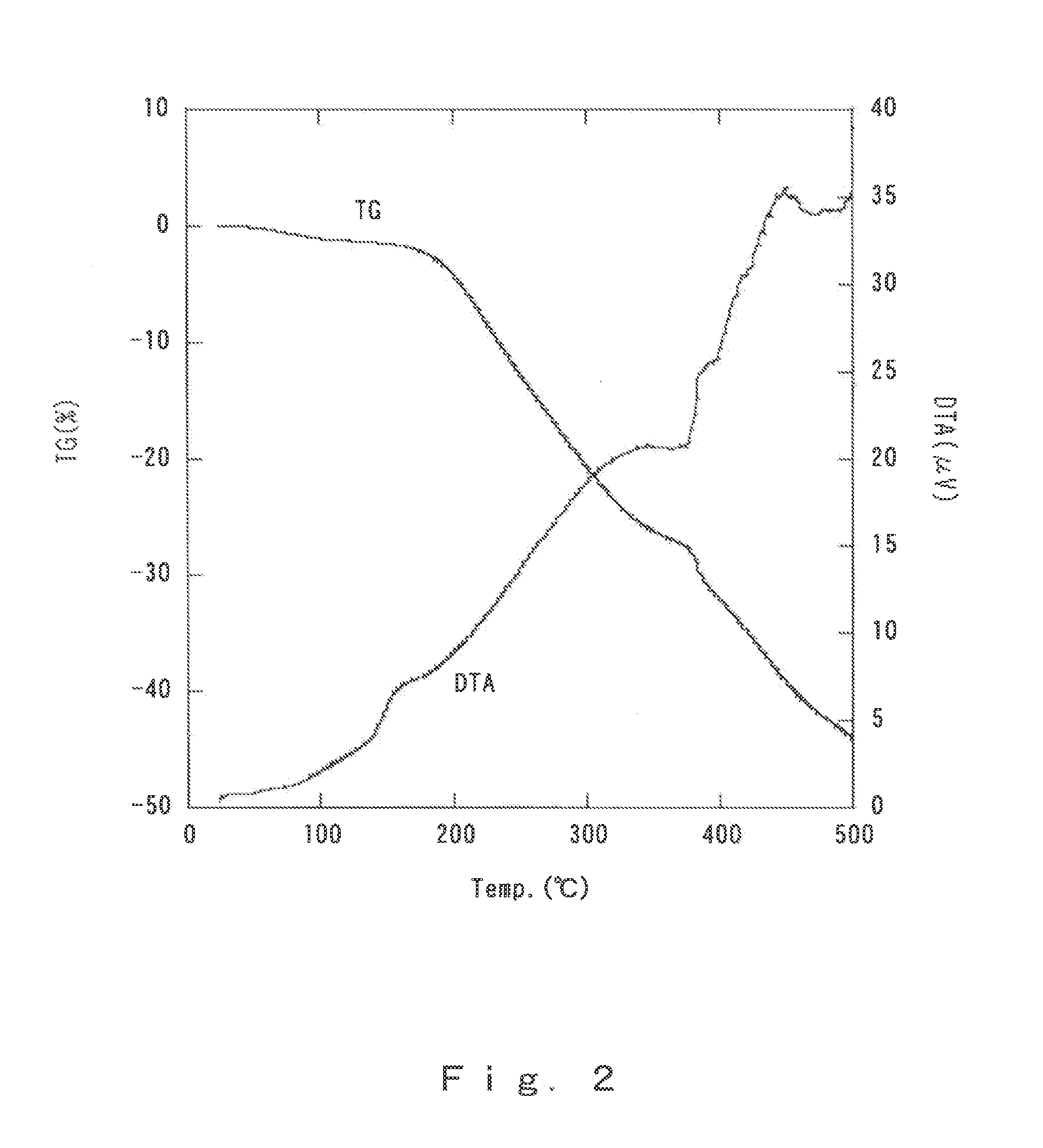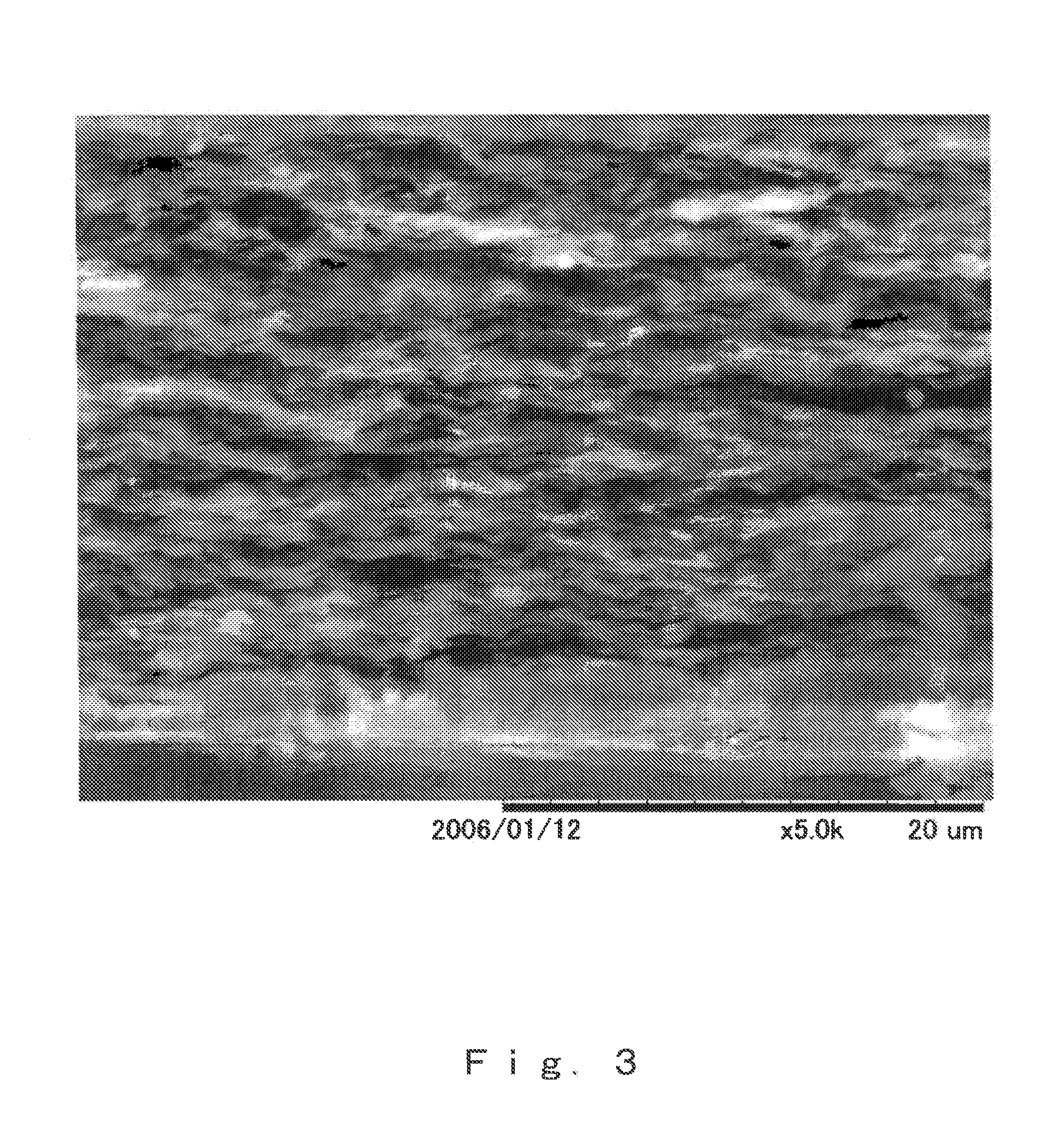Film made from denatured clay
a technology of denatured clay and film, which is applied in the field of denatured clay-based materials, can solve the problems of insufficient gas barrier properties of such materials, inability to mold compactly, and low gas barrier properties of inorganic sheets, and achieve excellent flexibility and sufficient mechanical strength.
- Summary
- Abstract
- Description
- Claims
- Application Information
AI Technical Summary
Benefits of technology
Problems solved by technology
Method used
Image
Examples
example 1
[0130](1) Manufacture of a Denatured Clay Thin Film
[0131]A commercially available product (by Hojun Co., Ltd.) in which a dimethylstearylbenzyl-type quaternary ammonium ions, and trimethoxysilane as a silylating agent, are introduced in natural bentonite, was used as a denatured clay. The denatured clay was added, in an amount of 14 g, to 440 cm3 of toluene, then the whole was placed, together with a Teflon™ rotor, in a plastic sealed container, followed by vigorous shaking for 2 hours at 25° C. to yield a homogeneous dispersion. The dispersion was divided into two, and then to each half there were added, respectively, 3 g of an epoxy resin (agent A) of a commercially available epoxy-based adhesive agent (by Konishi Co., Ltd.), and a denatured polyamide (agent B), followed by vigorous shaking to yield homogeneous dispersions. The two dispersions were mixed next, followed by further vigorous shaking for 20 minutes at 25° C. to yield a homogeneous clay paste.
[0132]This clay paste was ...
example 2
[0151](1) Manufacture of a Denatured Clay Thin Film
[0152]A commercially available product (by Hojun Co. Ltd.) in which a dimethylstearylbenzyl-type quaternary ammonium ions, and trimethoxysilane as a silylating agent, are introduced in natural bentonite, was used as a denatured clay. The denatured clay was added, in an amount of 14 g, to 440 cm3 of toluene, then the whole was placed, together with a Teflon™ rotor, in a plastic sealed container, followed by vigorous shaking for 2 hours at 25° C. to yield a homogeneous dispersion. The dispersion was divided into two, and then to each half there were added 3 g of an epoxy resin (agent A) of a commercially available epoxy-based adhesive agent (by Konishi Co., Ltd.), and a denatured polyamide (agent B), followed by vigorous shaking to yield homogeneous dispersions. The two dispersions were mixed next, followed by further vigorous shaking for 20 minutes at 25° C. to yield a homogeneous clay paste.
[0153]This clay paste was deaerated next i...
example 3
[0154](1) Manufacture of a Denatured Clay
[0155]Kunipia P (by Kunimine Industries, Inc.), which is a natural purified bentonite, was dispersed, in an amount of 60 g, in 600 cm3 of distilled water. The resulting dispersion was then mixed with 60 g of a commercially available tetrabutylammonium bromide special reagent, followed by shaking and stirring for 2 hours at 25° C., to prepare a homogeneous dispersion. This dispersion was subjected to solid-liquid separation in a centrifuge at 6000 rpm for 10 minutes, followed by further mixing over 20 minutes using a homomixer. The obtained solid was washed with water, was dried and crushed to prepare thereby a denatured clay.
[0156](2) Manufacture of a Denatured Clay Thin Film
[0157]The manufactured denatured clay was added, in an amount of 19.2 g, to 665 cm3 of toluene, then the whole was placed, together with a Teflon™ rotor, in a plastic sealed container, followed by vigorous shaking for 2 hours at 25° C. to yield a homogeneous clay paste. T...
PUM
| Property | Measurement | Unit |
|---|---|---|
| wt % | aaaaa | aaaaa |
| thickness | aaaaa | aaaaa |
| water absorption rate | aaaaa | aaaaa |
Abstract
Description
Claims
Application Information
 Login to View More
Login to View More - R&D
- Intellectual Property
- Life Sciences
- Materials
- Tech Scout
- Unparalleled Data Quality
- Higher Quality Content
- 60% Fewer Hallucinations
Browse by: Latest US Patents, China's latest patents, Technical Efficacy Thesaurus, Application Domain, Technology Topic, Popular Technical Reports.
© 2025 PatSnap. All rights reserved.Legal|Privacy policy|Modern Slavery Act Transparency Statement|Sitemap|About US| Contact US: help@patsnap.com



